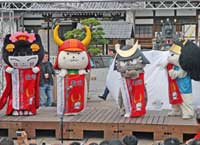Web Japan > Trends in Japan > Pop Culture > Mascots Making Waves
Mascots Making Waves
"Loose" Characters Employed to Boost Local Development
Local governments and other organizations are increasingly turning to mascot characters to boost regional development. The fact that these characters are somewhat less sophisticated than slick corporate mascots only appears to have added to their appeal. Certain of these beloved yuru kyara (literally "loose characters") are even transcending their home regions to become popular nationwide. And yuru kyara collectors' events are taking place across the country.
The Helmeted Cat
The term yuru kyara was coined by illustrator Jun Miura and refers to characters created by local governments and other groups in order to publicize events, attract tourists, or showcase local products. 2008 witnessed an explosion of interest in yuru kyara.
The reason for their popularity lies in their surprisingly unpolished and awkward appearance. Yuru kyara possess a certain warmth, which means that they fit nicely with the general trend toward seeking coziness and relaxation. Many of the characters were designed by ordinary citizens or local government officials and reflect too boldly the emotional attachment of their creators. The proportions of some designs also present difficulties in terms of scaling the character up to make a costume. It is these imperfections that make them "looser" than the meticulously designed characters common to anime and video games.
According to the results of the "Yuru Kyara Popularity Survey" conducted by Oricon Research, Inc., the most popular yuru kyara is Hiko-nyan, while the character Sento-kun ranked second. Hiko-nyan is a maneki-neko (a cat that beckons happiness with its paw) adorned with a red samurai helmet. It was created as a mascot for an event held in 2007 to mark the 400th anniversary of the construction of Hikone Castle in Hikone City, Shiga Prefecture. Even now, Hiko-nyan plays a part in attracting tourists by appearing on the grounds of Hikone Castle three times a day on weekends. Now a popular character throughout Japan, Hiko-nyan received over 7,800 New Year's greeting cards in January 2009, including some from overseas.
Sento-kun, meanwhile, is a boy sprouting a pair of deer's antlers from his head. He is the official mascot for events to be held in 2010 to commemorate the 1,300th anniversary of the city of Nara, the ancient capital of Japan, which is famous for the deer that roam some of its historic sites. Sento-kun drew much criticism after he was unveiled to the public, with some labeling him "unattractive" or "creepy." But the clamor garnered him even more attention and, in the end, he emerged a celebrity. Sales of Sento-kun goods, including calendars, badges, and ballpoint pens, are said to be going strong.
Boosting Local Development
A number of yuru kyara-themed events have also taken place around Japan. In Tottori Prefecture, the Yuru Kyara Cup at the Tottori Sand Dune was put on for the third time since 2007. In it, mascots from local governments in the surrounding area competed in an obstacle course, sumo wrestling, and other athletic events. Their clumsy movements lent an endearing quality to the life-sized mascots, and spectators were welcome to join in the event's final exercises.
The Yuru Kyara Festival in Hikone took place in October 2008 in Hikone City; Hiko-nyan invited fellow yuru kyara from all over Japan to participate. Forty-six thousand visitors assembled to see the 46 yuru kyara in attendance, and the event is said to have had a highly positive impact on the local economy.
And in November, the Yuru Kyara Local Development Summit was held in the city of Tajimi, Gifu Prefecture. Representatives from Japanese municipalities and their associated yuru kyara came together in an effort to leverage the power of yuru kyara to promote revitalization in Japan's provincial areas. (March 2009)




